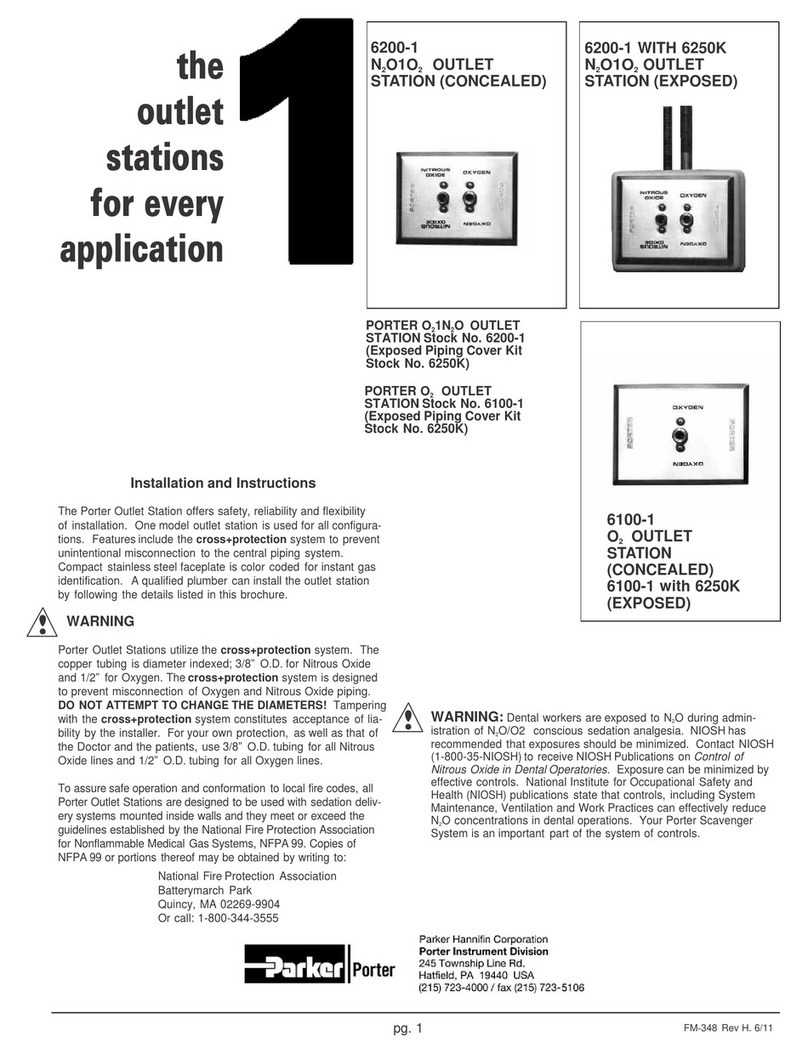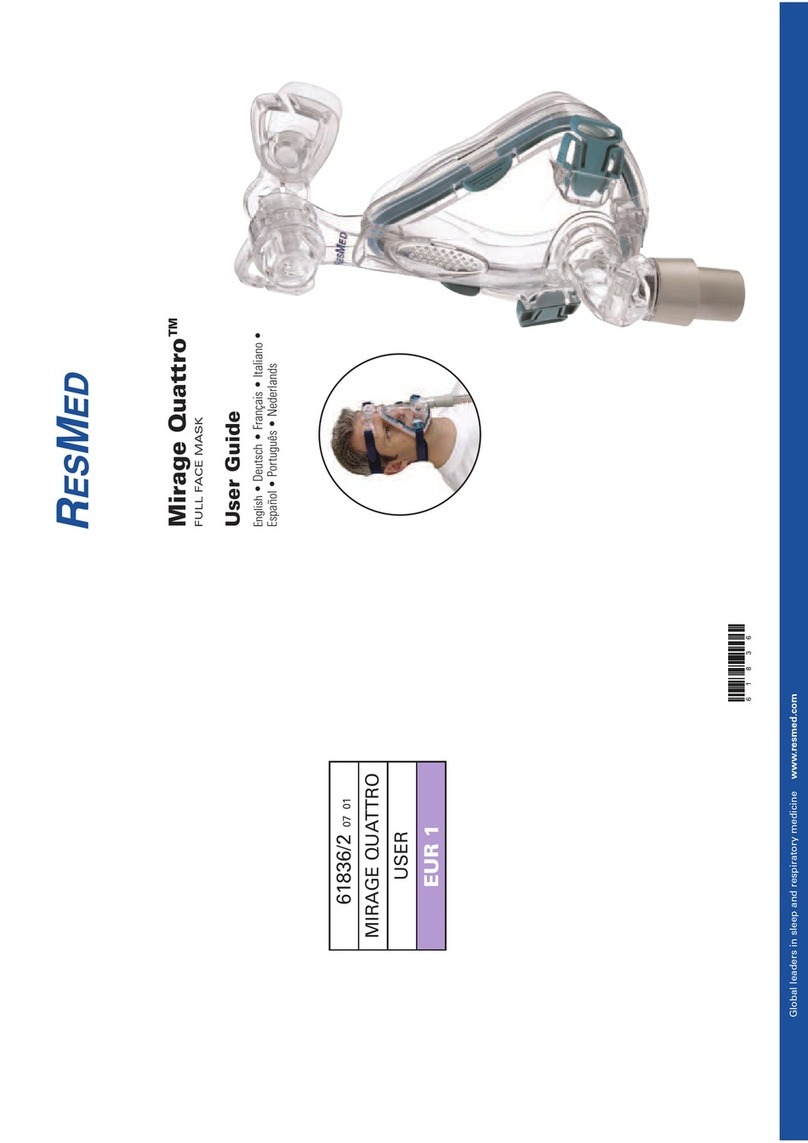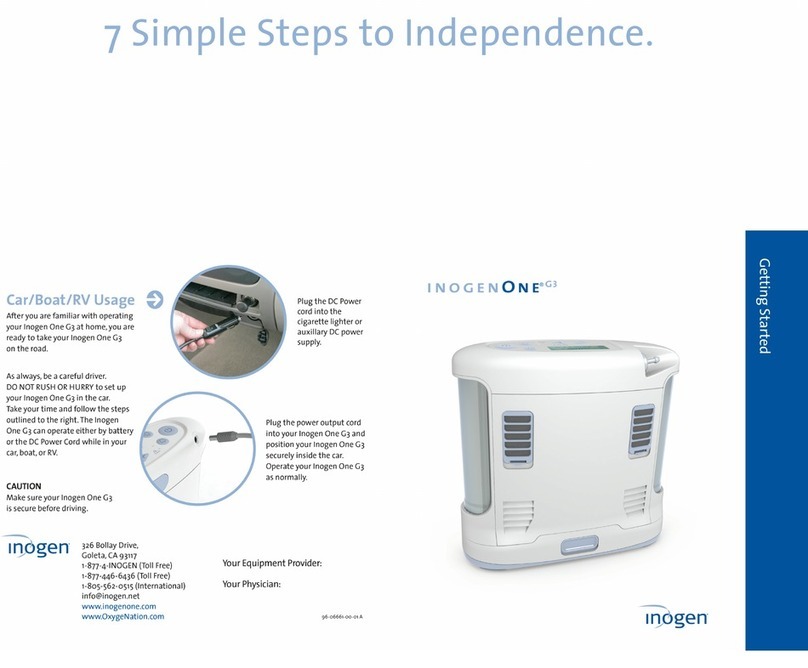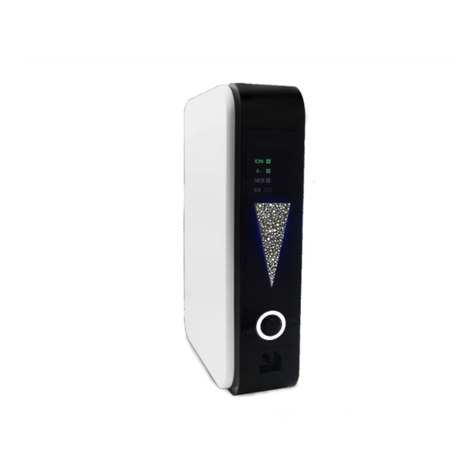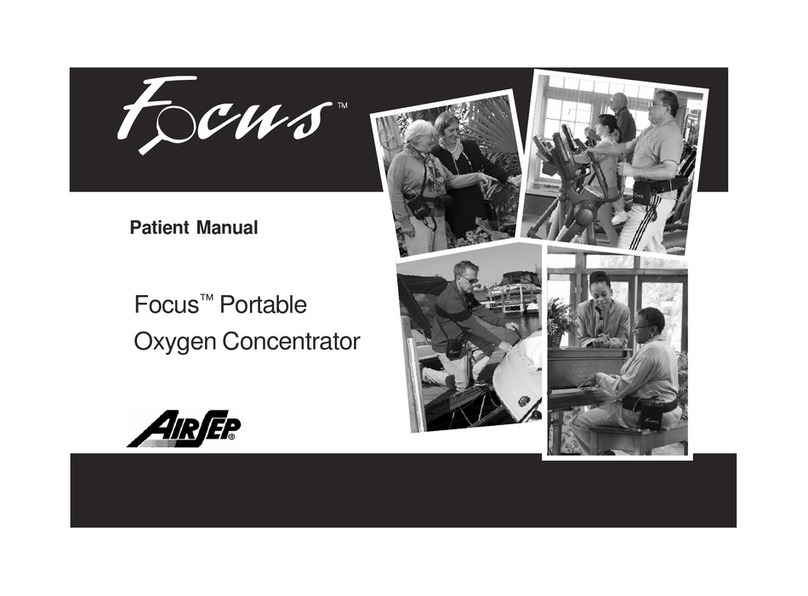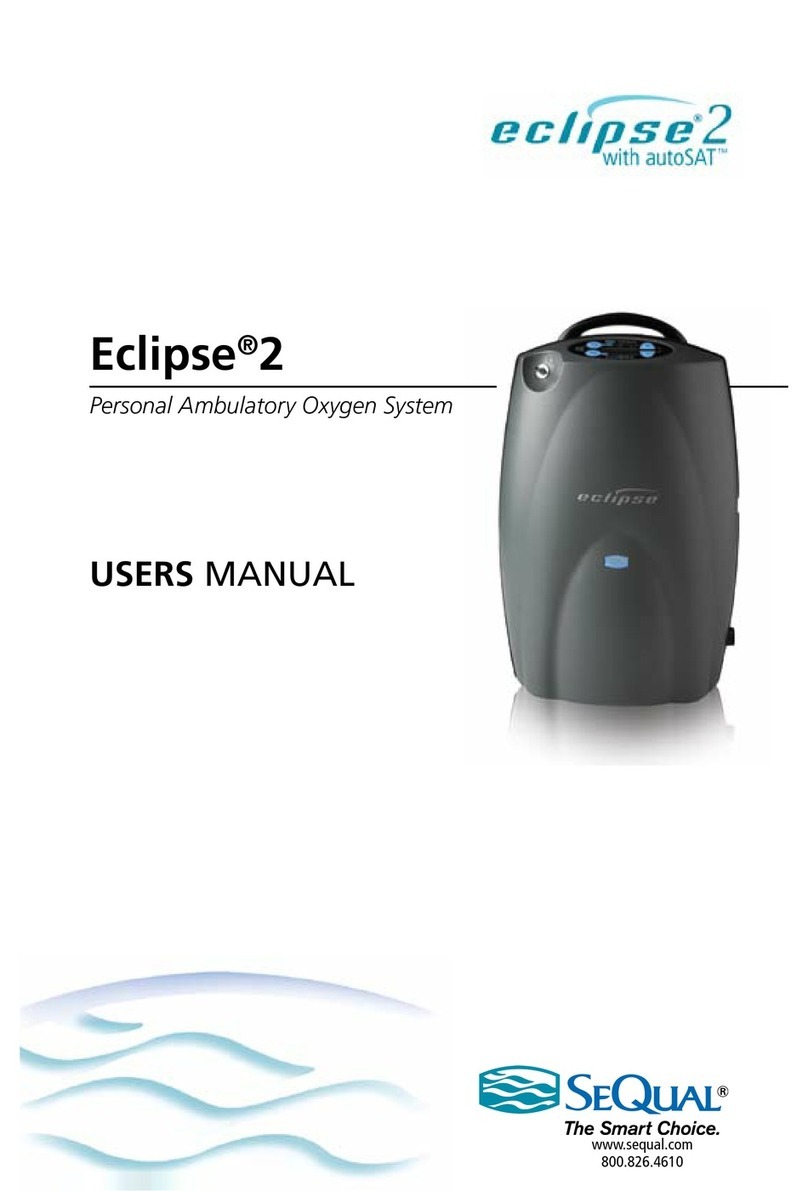devibliss 515DS User manual

CAUTION-Federal (U.S.A.) law
restricts this device to sale by or
on the order of a physician.
Service
Manual
DeVilbiss®
4 & 5-Liter Series Oxygen Concentrators
DANGER – NO SMOKING
For Product
Numbers:
515DS
515DZ
515KS
515KZ
515NS
515UK


3
TABLE OF CONTENTS
GENERAL INFORMATION
Introduction.............................................................................................................................................................................................................................4
Important Safeguards.............................................................................................................................................................................................................5
Safety Precautions and General Warnings........................................................................................................................................................................5
UNPACKING AND SETUP
Initial Inspection......................................................................................................................................................................................................................6
Patient Setup............................................................................................................................................................................................................................6
Operating Instructions..........................................................................................................................................................................................................6
MAINTENANCE
Patient Alert System ..............................................................................................................................................................................................................8
Routine Patient Maintenance...............................................................................................................................................................................................8
Periodic Homecare Provider Preventative Maintenance ..............................................................................................................................................8
Between Patient Maintenance.............................................................................................................................................................................................9
Preventative Maintenance Summary ..................................................................................................................................................................................9
TROUBLESHOOTING
System Operation................................................................................................................................................................................................................10
Normal Operating Sequence............................................................................................................................................................................................10
Simplified Troubleshooting.................................................................................................................................................................................................11
Troubleshooting Chart A ...................................................................................................................................................................................................12
Troubleshooting Chart B ...................................................................................................................................................................................................13
Troubleshooting Chart C...................................................................................................................................................................................................13
Troubleshooting Chart D ..................................................................................................................................................................................................13
Troubleshooting Chart E....................................................................................................................................................................................................13
Troubleshooting Chart F....................................................................................................................................................................................................14
COMPONENT TESTING, REPAIR, AND REPLACEMENT
Proper Repair Procedures.................................................................................................................................................................................................15
Cabinet Removal..................................................................................................................................................................................................................15
Accumulator Pressure Test................................................................................................................................................................................................16
Capacitor ...............................................................................................................................................................................................................................16
Compressor ..........................................................................................................................................................................................................................16
Cooling Fan ...........................................................................................................................................................................................................................18
Final Check Valve..................................................................................................................................................................................................................18
Flow Meter............................................................................................................................................................................................................................18
Four-Way Valve .....................................................................................................................................................................................................................18
Hour Meter...........................................................................................................................................................................................................................19
Molecular Sieve Beds...........................................................................................................................................................................................................20
OSD (Oxygen Sensing Device).........................................................................................................................................................................................20
Power Cord...........................................................................................................................................................................................................................20
Power Switch ........................................................................................................................................................................................................................20
Pressure Regulator ..............................................................................................................................................................................................................21
Printed Circuit Board (PC board) ...................................................................................................................................................................................21
Sieve Bed Check Valves ......................................................................................................................................................................................................21
FIGURES, DIAGRAMS,AND VIEWS
Figure Index...........................................................................................................................................................................................................................22
Exterior Views.................................................................................................................................................................................................................23-25
Interior Views..................................................................................................................................................................................................................26-37
Other Figures .................................................................................................................................................................................................................38-41
Wiring and Pneumatic Diagrams................................................................................................................................................................................42-44
WARRANTY INFORMATION........................................................................................................................................................................................45
ORDERING INFORMATION AND PARTS LIST
Ordering Information..........................................................................................................................................................................................................46
Parts Return and Ordering Policy....................................................................................................................................................................................46
Parts List ..........................................................................................................................................................................................................................47-48
SPECIFICATIONS.................................................................................................................................................................................................................49

4
GENERAL INFORMATION
INTRODUCTION
This service manual was designed to provide Sunrise
Medical Respiratory Products Division qualified service
technicians and homecare providers with the proper main-
tenance, service, safety, and repair procedures for the
DeVilbiss Oxygen Concentrator.
Read and understand all the information contained in this ser-
vice manual before attempting to operate or perform any
maintenance on the concentrator.
An oxygen concentrator is a device that delivers highly con-
centrated oxygen for therapeutic applications.
Room air is a mixture of 78% nitrogen, 21% oxygen, 1% argon
and other gases.The concentrator draws in room air, sepa-
rates the nitrogen from the oxygen, and delivers concentrated
oxygen to the patient through an oxygen port.
For more in-depth classroom type training, Sunrise Medical
holds oxygen concentrator service schools. For service
school information, contact the Service Department at
11-800-333-4000 (8114-443-48811).
NOTE: Sunrise Medical reserves the right to alter or change the
design of the DeVilbiss Oxygen Concentrator series. Hence, slight
differences in construction or components may exist between the
unit in hand and what is described in this manual.

5
GENERAL INFORMATION
IMPORTANT SAFEGUARDS
Read all instructions before operating the oxygen concentra-
tor. Important information is highlighted by these terms:
WARNING: Safety information for hazards that might
cause serious injury or death.
CAUTION: Information for preventing damage to
the product.
NOTE: Information to which you should pay special attention.
SAFETY PRECAUTIONS AND GENERAL WARNINGS
A. Federal (U.S.A.) law restricts this device to sale by or on the
order of a physician.
B. WARNING: Oxygen promotes rapid burning. Do
not smoke when using this unit or when near a
person receiving oxygen therapy. Do not operate the
oxygen concentrator within a minimum of five feet
(1.6m) from hot, sparking, or burning objects or naked
flames. Do not use in rooms heated by paraffin or
portable gas heaters.
C. Do not place a humidifier with an oxygen patient unless pre-
scribed by a physician and then only a bubble-type humidifier
should be used.
D. Do not connect the oxygen concentrator to an electrical out-
let controlled by a wall switch; the outlet should be indepen-
dent of other appliances.
E. Do not use an electrical adapter or extension cord with the
oxygen concentrator.
F. Only operate the oxygen concentrator with all filters in place;
do not operate if the air filter is wet.
G. WARNING: Electric shock hazard. Do not remove cab-
inet.The cabinet should only be removed by a qualified
Sunrise Medical homecare provider.
H. WARNING: Disconnect the power cord from the wall
outlet before attempting repairs on the unit. Extra
care should be taken if it is necessary to operate the
unit with the cabinet removed.
I. WARNING: Do not use oils, greases, or any petrole-
um-based solvents/cleaners on or near the unit. Use
only materials that are compatible with oxygen.
J. WARNING:When replacing the capacitor, do not
touch the terminals or allow metal objects to come in
contact with the terminals on the capacitor.The
capacitor can retain a dangerous charge level for sev-
eral days after the unit is turned off.The capacitor is
located in the base of the unit next to the cooling fan.
K. Use only Sunrise Medical concentrator replacement parts and
accessories.
L. Do not use regenerated sieve material.

6
UNPACKING AND SETUP
INITIAL INSPECTION
It is suggested that an initial inspection be performed upon
receiving the oxygen concentrator.
1. After removing the DeVilbiss Oxygen Concentrator from the
carton, examine it for any external damage. If shipping damage
has occurred, contact the Sunrise Medical Customer Service
Department at 1-800-333-4000 (814-443-4881) for specific
instructions. Save the carton for possible later return; note
the position of the unit and placement of the packing material.
2. Open the filter door (Figure 3) and record the number of
hours on the hour meter. Check to make sure the air filter is
in place.
3. Check to be sure the intake bacteria filter (Figure 4) is in place.
4. Plug the unit into an electrical outlet, turn the unit “On,” and
check the audible and visible alarms.
5. Set the flow meter to maximum recommended liter flow and
let the unit run for at least 20 minutes.
6. Use an oxygen analyzer to check the concentration.
NOTE: If the unit fails to operate properly (oxygen concen-
tration not within specification) or if internal damage is found,
contact the Sunrise Medical Customer Service Department at
1-800-333-4000 (814-443-4881).
PATIENT SETUP
1. Position the unit near an electrical outlet in the room where
the patient spends most of his or her time.
NOTE: Do not connect to an electrical outlet controlled by a
wall switch.The outlet should be independent of other appliances.
2. Position the unit at least 6 inches (16 cm) from walls,
draperies, or any other objects that might prevent the proper
flow of air in and out of the oxygen concentrator.
3. Locate the unit a minimum of 5 feet (1.6 meters) from fire-
places, radiators, heaters, and hot-air registers.
WARNING: Oxygen promotes rapid burning. Do
not smoke when using this unit or when near a
person receiving oxygen therapy. Do not operate the
oxygen concentrator within a minimum of 5 feet (1.6
meters) from hot, sparking, or burning objects or
naked flames. Do not use in rooms heated by paraffin
or portable gas heaters.
WARNING—Electric Shock Hazard. Only qualified
Sunrise Medical homecare providers may remove
the cabinet.
4. Attach the appropriate oxygen accessories (oxygen tubing or
humidifier) to the oxygen outlet port.
NOTE: A maximum of 50 feet (15 meters) of tubing plus 7
feet (2.1meters) of cannula plus a bubble humidifier is allowed
between the concentrator and the patient.
OxygenTubing Only Connection (Figure 1)
1. Thread the cannula fitting (part #CN100) onto the oxygen
outlet port.
2. Attach the 5/32”(4 mm) I.D. oxygen tubing (part #OST07,
OST15, OST25, or OST50).
OxygenTubing with Humidification Connection
If the physician has prescribed an oxygen humidifier as part of
the patient’s therapy, follow these steps:
1. Fill the humidifier bottle (part #HUM16) with distilled water.
Do not overfill. (If using a prefill, go to Step 3.)
2. Thread the wing nut located on the top of the humidifier bot-
tle to the oxygen outlet port so that it is suspended. Make
sure it is securely tightened.
3. Attach the 5/32" (4 mm) I.D. oxygen tubing (part # OST07,
OST15, OST25, or OST50), not to exceed 50 feet (15
meters), directly to the humidifier bottle outlet fitting.
NOTE: For optimum performance, the DeVilbiss Oxygen
Concentrator has a preset nominal output pressure of 8.5 psi
(58.6 kPa). Use only “bubble-type”humidifiers. Do not use
“jet-type”humidifiers.
NOTE: Condensation from the humidifier may occur in
longer lengths of tubing or if the tubing is laying on a cold
floor.This can be reduced by using a removable humidifier
stand (part #MC44DM-509).
To use the stand:
1. Attach a straight humidifier adapter fitting (part #444-506) to
the bottle by turning the wing nut on the humidifier until it is
tight on the fitting.
2. Secure the bottle in the strap.
3. Attach one end of the oxygen tubing to the oxygen outlet on
the unit and the other end to the plastic adapter fitting on the
humidifier. Locate the humidifier near the patient.
When ready for operation
1. Attach the nasal cannula (part #CAN00), catheter, or face
mask to the oxygen tubing (per the manufacturer’s directions).
2. Follow the operating instructions given below.
OPERATING INSTRUCTIONS
1. Remove the power cord completely from the strap. Make sure
the power switch is in the “Off”position.
2. 115 Volt Units–Insert the plug into an electrical outlet.The
DeVilbiss Oxygen Concentrator uses a two-prong polarized
plug and is double-insulated to protect against electric shock.
230 Volt Units–The DeVilbiss Oxygen Concentrator is dou-
ble-insulated to protect against electric shock. Insert the line
cord into the IEC power connector located on the back of
the unit. Insert the plug into an electrical outlet.

7
UNPACKING AND SETUP
WARNING:The plug on the DeVilbiss 515DZ and
515DS concentrators has one blade wider than the
other.To reduce the risk of electric shock, this plug is
intended to fit in a wall outlet only one way. Do not
attempt to defeat this safety feature.
WARNING: Improper use of the power cord and plugs
can cause a burn, fire, or other electric shock hazards.
Do not use the unit if the power cord is damaged.
WARNING: Oxygen promotes rapid burning. Do
not smoke when using this unit or when near a per-
son receiving oxygen therapy. Do not operate the oxygen
concentrator within a minimum of five feet (1.6m) from
hot, sparking, or burning objects or naked flames. Do not
use in rooms heated by paraffin or portable gas heaters.
3. Press the power switch to the “On”position.When the unit is
turned on, the “Service Required”light will illuminate and an
audible signal will sound (the patient alert system) momentari-
ly. The “Power”light also illuminates.
Only DeVilbiss Oxygen Concentrators with OSD®
NOTE: There are two 515 OSD concentrator models
referred to throughout this Service Manual:
•Early - OSD models
(Concentrator serial number H19999 and lower)
•Later - OSD models
(Concentrator serial number H20000 and higher)
The OSD is an optional device within DeVilbiss concentrators
that monitors the oxygen produced by the unit.The OSD
operates as follows:
•Normal Oxygen (green light) - oxygen purity normal
•Low Oxygen (yellow light) - oxygen purity low–requires servicing
NOTE: If the oxygen purity continues to fall, an audible signal
will sound intermittently. If the oxygen purity continues to fall
to a low enough level, the yellow “Low Oxygen”light will turn
off and the red “Service Required”light will turn on.
NOTE: Refer to “Specifications”for specific alarm settings.
When the unit with the OSD is turned “On,”all four indicator
lights (Power, Service Required, Low Oxygen, and Normal
Oxygen) on the front panel will briefly illuminate. After a few
seconds, only the “Power”and “Normal Oxygen”lights will
remain on.
NOTE: After Power On, the OSD conducts a continuous
diagnostic evaluation to check for a fault in the piezo electron-
ics. If this condition is detected by the OSD electronics at any
time duing concentrator operation, the green “Normal
Oxygen”OSD light will turn off and the beeping audible and
blinking red “Service Required”light alarms activate.
Otherwise for the first fifteen minutes of operation, the
green “Normal Oxygen”light will remain illuminated
during the oxygen stabilization process.After that
time, the OSD will begin monitoring the oxygen purity
every second.
4. Slowly turn the flow meter knob until the flow meter ball is
centered on the line next to the appropriate flow rate.
NOTE: When the flow meter knob is turned clockwise, the
flow decreases (and eventually will shut off the oxygen flow).
When the knob is turned counter-clockwise, the flow increases.
NOTE: Use low output flow meter (part #515LF-607) for
flow rates under 1lpm.
NOTE: The unit may require up to 20 minutes for the oxygen
concentration and flow rate to stabilize.The flow rate should
be monitored and readjusted if necessary.
5. The flow meter has a locking device. If it is necessary to pre-
set and lock in the prescribed flow rate, tighten the set screw
located on the hex nut just below the control knob using a
1/16" Allen bit. No adjustment can be made without loosening
the set screw.
6. The DeVilbiss oxygen concentrator is now ready for use.

8
MAINTENANCE
PATIENT ALERT SYSTEM
The DeVilbiss Oxygen Concentrator patient alert
system will detect unit component failure.This system is com-
prised of both visible and audible alarms which signal the patient
if a malfunction should occur.
The visible alarm located on the front panel (Figure 1) reads
“Service Required.”The audible alarm system is internally
powered; no batteries are required.When the indicator lights
illuminate or the audible alarm sounds, other than during unit
start-up, a problem has occurred.
Non-OSD and early-OSD models:
•Power Failure (Blinking red “Service Required”light
and pulsing audible alarm)
•Low Pressure (Continuous red “Service Required”light and
audible alarm)
•Below Normal Oxygen - OSD models only (Less than 85%,
yellow “Low Oxygen”light. Less than 75%, yellow “Low
Oxygen”light and audible alarm)
Later OSD models:
•Power Failure (Blinking red “Service Required”light
and pulsing audible alarm)
•Low Flow (Below 0.5 lpm) (Continuous red “Service
Required”light and audible alarm)
•Below Normal Oxygen (83.5% to 75%, yellow “Low Oxygen”
light. 75% to 60%, yellow “Low Oxygen”light and beeping audi-
ble alarm. Less than 60%, red “Service Required”light and
beeping audible alarm.)
The visible and audible alarms will activate for approximately
15 minutes in a no power situation. If the unit is turned “On”
and later the power is removed, no alarm will sound for the
first 10 seconds.After that time, the alarm will produce an
audible pulse every few seconds while the visible alarm blinks.
NOTE: If the concentrator has been unused for an extended
period, the unit must run several minutes before the power
fail alarm will activate.
The printed circuit (PC) board (Figure 5) is responsible for
controlling the system and alarms.
NOTE: A high pressure condition is indicated by the audible
(a “popping”sound) release of pressure from a pressure relief
valve located on the compressor head.
ROUTINE PATIENT MAINTENANCE
The oxygen patient should perform the following maintenance:
Oxygen Humidifier (reusable bottles only)
The patient should clean the humidifier bottle daily.The
patient should follow the instructions supplied by the manufac-
turer. If no cleaning instructions were supplied, these steps
should be followed:
•Wash the humidifier bottle in a solution of hot water and
dishwashing detergent.
•Soak the humidifier in a solution of one part white vinegar to
three parts hot water for 30-45 minutes.This solution acts as
a germicidal agent.
•Rinse thoroughly with hot tap water and refill with distilled
water for use. Do not overfill.
Cannula/Mask and Tubing
The patient should clean and replace the cannula or mask and
tubing as instructed by the manufacturer.
Air Filter and Oxygen Outlet Connector
The air filter (Figure 3) and oxygen outlet connector should
be cleaned at least once a week by the patient.To clean, these
steps should be followed:
1. Remove the air filter located in the door on the back of the unit.
Remove the oxygen outlet connector (if used) from oxygen out-
let port (Figure 1).
2. Wash in a solution of warm water and dishwashing detergent.
3. Rinse thoroughly with warm tap water and towel dry.The fil-
ter should be completely dry before reinstalling.
WARNING: Do not attempt to operate the unit with-
out the air filter or while the filter is still damp.
NOTE: The air filter should be monitored more closely in
environments with abnormal amounts of dust and lint.
CAUTION: Operation of the DeVilbiss Oxygen
Concentrator in extreme environments or without
the air filter will prematurely occlude the intake bac-
teria filter and cause a decrease in the unit perfor-
mance.
Exterior Cabinet
The patient should clean the concentrator exterior cabinet by
using a damp cloth or sponge with a mild household cleaner
and wiping it dry.
WARNING: Do not apply liquids directly to the
cabinet or utilize any petroleum-based solvents or
cleaning agents.
PERIODIC HOMECARE PROVIDER
PREVENTATIVE MAINTENANCE
Every DeVilbiss Oxygen Concentrator is tested at the factory.
To assure continued trouble-free performance, the following
preventative maintenance should be performed by the home-
care provider during periodic oxygen patient visits. Failure to
properly maintain the unit will void the warranty.
1. Check the oxygen concentration with an oxygen analyzer
(part #O2ANA)—every 3 months on non-OSD units or every
two years on OSD units.
a. Calibrate the oxygen analyzer prior to checking the oxy-
gen concentration.The analyzer should be properly cali-
brated using the manufacturer’s recommended procedure.
NOTE: Changes in temperature, altitude, or humidity may
affect the analyzer’s oxygen concentration reading.The
analyzer should be calibrated in similar conditions to the
location of the concentrator.

9
MAINTENANCE
b. The concentrator must operate for a minimum of 20 min-
utes before checking the oxygen concentration.
c. Connect the analyzer to the unit’s oxygen outlet port
(Figure 1) and wait until the display stabilizes.
d. Record the reading.
2. Check the audible alarm and indicator lights every two years.
When the power switch is turned “On,”listen for the audible
alarm and check to see if the front panel indicator lights are
operating.
3. Change intake filter as follows:
a. Extended life intake bacteria filter (part # MC44D-605) -
Inspect once a year. Change as necessary, not to exceed
8760 hours.
b. Round felt pre-filter (part # 444-503) - change once a
month. –OR–Rectangular felt pre-filter (part # MC44D-
722) - change every 3 monthes,AND
c. Intake bacteria filter (part # 444-504) - change every six
months.
d. Open the filter door and replace filters as required.
4. Change the final bacteria filter (part #PV5LD-651) every
two years.
a. Unplug the unit, remove the cabinet, and loosen the bib.
b. Remove the hose from each end of the filter (Figure 8)
and discard the filter.
c. Install the new final bacteria filter with the “IN”fitting
toward the flow meter.
d. Tighten the bib and replace the cabinet.
5. Check the system performance every two years of operation
by measuring the accumulator pressure swing. Use the accu-
mulator pressure test described in the chapter “Component
Testing, Repair and Replacement.”
6. Change the compressor HEPA filter—every five years or
25,000 hours of operation (whichever comes first).
a. Unplug the unit and remove the rear cabinet.
b. Loosen the hose clamp and remove the hose from the
outlet fitting end of the HEPA filter (Figure 4).
c. Using a wrench, unscrew the HEPA filter from the com-
pressor head outlet fitting.
CAUTION: Use a second wrench to prevent twist-
ing of the brass angle fitting screwed into the out-
let port of the compressor.
d. Discard the HEPA filter.
NOTE: Teflon®tape or LOX-8®paste should be applied to
the compressor fitting omitting the first thread, prior to
installation of the HEPA filter.
e. Install the new HEPA filter by using a wrench to attach the
filter to the compressor head outlet fitting.
CAUTION: Use a second wrench to prevent twist-
ing of the brass angle fitting screwed into the out-
let port of the compressor.
NOTE: Make sure the filter end marked “IN”is toward
the compressor.
f. Attach the hose to the outlet fitting end of the filter and
secure with a hose clamp.
7. Leak test the HEPA filter fittings.Apply a leak test solution
such as Epi-SEAL®LEAK-SEEK®to fittings and connections
with the unit running. If an air leak is present, the solution
will bubble.
The Preventative Maintenance Schedule stated above reflects a
normal, clean operating environment.The homecare provider
is responsible for determining the condition of the concentra-
tor operating environment and determining a preventative
maintenance interval frequency.
NOTE: This PM Schedule reflects:
•5000 hour usage equal to one year
•a normal, clean operating environment.
The homecare provider is responsible for:
•determining the condition of the concentrator operating
environment.
•determining a preventative maintenance interval frequency
(not to exceed the schedule stated above which takes into
consideration the specific operating environment).
BETWEEN PATIENT MAINTENANCE
1. Discard oxygen tubing, cannula & humidifier bottle.
2. Discard intake bacteria filter and felt pre-filter (if using these
filters instead of the extended life intake bacteria filter).
3. Wash or replace the cabinet air filter.
4. Wash the concentrator cabinet.
5. Check oxygen concentration. If the unit falls within specifica-
tion, the extended life intake bacteria filter does not need to
be replaced between patients.
PREVENTATIVE MAINTENANCE SUMMARY
Patient
Daily Clean the humidifier bottle (if used).
Weekly Clean air filter on back of unit.
Clean exterior of cabinet.
Other Clean and replace cannula/mask and tubing as
instructed by manufacturer.
Homecare Provider
Change intake filter as necessary following require-
ments in step 3.
3 months Check oxygen concentration on non-OSD units.
Check the concentrator environment, and set a
maintenance interval of less than 3 months if
required.
2 years Check audible alarm and indicator lights.
Change final bacteria filter.
Check system performance.
Check oxygen concentration on OSD units.
5 years Change compressor HEPA filter
(change in 25,000 hours or earlier).

10
TROUBLESHOOTING
SYSTEM OPERATION
The DeVilbiss Oxygen Concentrator uses a pressure swing
adsorption system.The air is drawn into the unit through air
filters and into a double-head compressor.
A pneumatic diagram of the system is shown in Figure 15.
The compressed air passes through a four-way valve (Figure 5),
which is cycled at a pre-determined rate, and is directed into
one of two sieve beds.The sieve beds contain molecular sieve
material which is a synthetically-produced inorganic silicate. It is
very porous and has the unique ability to selectively adsorb
nitrogen from the air as it passes through the sieve bed.
As one bed is being pressurized, the other bed is quickly
depressurized.This allows the nitrogen that was adsorbed
during its pressurization cycle to be exhausted from the
sieve material.
The nitrogen is released through exhaust ports located on the
four-way valve assembly.The ports are connected to a single
piece of black hose running from the valve to the exhaust muffler.
Also during each bed pressurization, a small amount of oxygen
flows through an orifice (Figure 9) from the pressurized bed
into the depressurizing bed.The orifice is clamped inside a long
piece of blue tubing connecting the outlets of the two sieve
beds.This helps purge the nitrogen from the depressurizing bed.
The beds will continue to be alternately pressurized and
depressurized as the unit operates.
Oxygen leaving the sieve beds is directed through a check
valve to the accumulator tank.A pressure regulator (Figure 9)
on the tank controls the oxygen pressure as it leaves the
accumulator and enters the flow meter.The flow meter allows
the oxygen flow to be controlled and adjusted to the level
prescribed by the patient’s physician. From the flow meter the
oxygen passes through the final bacteria filter (Figure 8), a
check valve, and finally the oxygen outlet port to the patient.
The DeVilbiss Oxygen Concentrator operates on a timed
cycle.The cycling is controlled by the PC board.The PC board
will send approximately 7.5VDC (12-15 VDC on non-OSD
and early-OSD models) to the four-way valve causing one of
the two solenoids to energize.
The PC board also activates the electronic alarm system.A
high pressure condition will be indicated with a “popping”type
sound produced by release of pressure from a pressure relief
valve on the compressor head.
NORMAL OPERATING SEQUENCE
When the concentrator is turned “On,”the following normal
cycling sequence should be observed by attaching pressure
gauges to the sieve bed test points.
1. The four-way valve is quickly cycled back and forth several times
to relieve residual bed pressure preventing a static condition in
the compressor.This rapid cycling only happens on start-up.
NOTE: The rapid cycling will be heard as several thumping
noises at start-up.
2. An approximately 7.5VDC (12-15 VDC on non-OSD and
early-OSD models) signal from the PC board is supplied to
the right solenoid for approximately 9-10 seconds.The left
sieve bed pressurizes while the right sieve bed is being depres-
surized to approximately 2 PSI (14 kPa).
3. The signal is then removed from the right solenoid. No voltage
is applied to either solenoid for approximately 1second. Both
sieve beds are being equalized in pressure during this phase.
4. An approximately 7.5VDC (12-15 VDC on non-OSD and
early-OSD models) signal from the PC board is applied to the
left solenoid for approximately 9-10 seconds.The right sieve
bed pressurizes while the left sieve bed is depressurized to
approximately 2 PSI (14 kPa).
5. The signal is then removed from the left solenoid. No voltage
is applied to either solenoid for approximately 1second. Both
sieve beds are being equalized in pressure during this phase.
6. The cycle then repeats with step 2.
NOTE: High-end sieve bed pressure should not exceed 1/2
PSI (4 kPa) above high-end accumulator pressures. Refer to
“Specifications”for normal pressures obtained during the cycle.

11
TROUBLESHOOTING
SIMPLIFIED TROUBLESHOOTING
The key to simple troubleshooting is to recognize which type
of problem exists and select the most effective approach to
solving the problem.The different types of problems and the
approaches for solutions are as follows:
Type I—The unit runs but a low pressure, low output
flow or high pressure condition exists.
NOTE: Low pressure and low flow are indicated by both a
visible and audible alarm. High pressure is indicated by a “pop-
ping”sound caused by the pressure relief valve.
NOTE: Non-OSD and early OSD models were equipped with
the low pressure alarm. Later OSD models are equipped with
the low flow alarm.
1. Connect test gauges.
2. Refer to the “Normal Operating Sequence”to make sure the
unit is cycling properly.
3. If bed pressure is rising slowly, check for occluded filters and
severe leaks. If filters are clean and there are no leaks, then
the compressor is defective.
4. If the pressure relief valve is releasing pressure, observe
whether the unit is cycling or not.
5. If the unit is not cycling, this indicates that the four-way valve
is not shifting.
6. If the unit is cycling in conjunction with very high bed pres-
sures, this indicates defective sieve beds.
Type II—The compressor will not start when the unit
is turned on.
1. Verify that the cooling fan is running; if it is not, determine
where you are losing power.
2. Check for compressor voltage at the compressor connector.
3. If voltage is present, then the capacitor or compressor is
defective.
4. If voltage is not present, the wire harness is defective.
WARNING: Mechanical Hazard. Keep fingers, loose
clothing, etc. away when working on compressor.
Type III—The concentrator runs and continues to
cycle but has low oxygen concentrations.
1. Connect test gauges and check for higher or lower than nor-
mal bed pressures.
A.High pressures indicate defective sieve beds.
B. Low pressures indicate occluded filters, leaks, or defec-
tive compressor.
2. Check for oxygen leaks at:
•sieve beds •flow meter
•accumulator tank •final bacteria filter
•pressure regulator •final check valve
•OSD •outlet port
NOTE: Check for leaks using a certified leak detection solu-
tion.Apply leak test solution to all fittings and hose connec-
tions with unit running. If an air leak is present, the solution
will bubble.All leaks should be repaired before putting the unit
back in service.
3. Test accumulator tank pressure. If pressure is lower than nor-
mal, then sieve bed check valves are defective.
NOTE: For normal system pressures refer to “Specifications”.

12
TROUBLESHOOTING
TROUBLESHOOTING CHART A
Visible Alarm Audible Alarm Compressor Power Light
OFF OFF ON ON
Other Symptoms Possible Cause Possible Remedy
Pulsating air noise Intake filter not in place or defective Check filter and replace if necessary
Compressor intake hose disconnected Reconnect hose
Excessive noise Loose or defective motor mounts Replace motor mounts
Defective compressor Replace compressor
Defective cooling fan Replace cooling fan
Fluctuating oxygen flow Occluded humidifier Clean or replace humidifier
Use of improper humidifier Use only a bubble-type humidifier
Occluded filters Clean or replace filters
Occluded or defective cannula and tubing Detach cannula from oxygen delivery tubing. If
proper flow is not attained, check tubing for
kinks or other obstructions. Clean or straighten
as required or replace tubing if necessary.
Use of excess oxygen tubing The unit is designed to deliver 5 lpm with a
cannula on 50 feet (15 meters) of approximately
5/32”(4 mm) inside diameter tubing. Smaller
diameter tubing or the addition of any other
flow restriction may prevent obtaining the
desired flow rate.
Defective flow meter Replace flow meter
Leak in system Check for leaks in all hoses and fittings
Defective compressor Replace compressor
Defective compressor reed valve Replace compressor reed valve
Defective check valve Replace check valve
Pressure regulator not adjusted Adjust or replace pressure regulator
properly or defective
Little or no oxygen flow Flow meter not adjusted properly Adjust flow meter
Hose disconnected to flow meter Reconnect hose
Oxygen delivery tubing is kinked or blocked Straighten tubing or remove obstruction
Occluded humidifier Clean or replace humidifier
Low oxygen concentration Leak in system Check for leaks in all hoses and fittings
Defective sieve bed check valve Replace check valve
Defective compressor reed valve Replace compressor reed valve
Defective compressor Replace compressor
Four-way valve not fully shifted Clean or replace four-way valve
Occluded filters Clean or replace filters
Contaminated sieve beds Replace sieve beds
Audible alarm does not Unit has not been used for an extended Allow unit to run for 20 minutes and retry
sound during power failure period of time. NOTE: If the concentrator
has been unused for an extended period,
the unit must run several minutes before
the power fail alarm will activate.
Defective PC board Replace PC board
Defective power switch Replace power switch
Defective wire harness Replace wire harness
Audible alarm does not sound when Defective PC board Replace PC board
unit is turned “On”
Pressure relief valve activated - Defective PC board Replace PC board
“popping”sound Defective valve Replace valve
Service Required light does not Defective PC board Replace PC board
illuminate when unit is turned “On.”Defective light Replace light
PC board connectors not properly latched Be sure tabs are pushed completely into place

TROUBLESHOOTING CHART D
Visible Alarm Audible Alarm Compressor Power Light
ON ON OFF ON
Other Symptoms Possible Cause Possible Remedy
Fan operating Wiring harness disconnected/defective Reconnect/replace wiring harness
Loose compressor wire Tighten or attach wire
Defective capacitor Replace capacitor
Defective compressor Replace compressor
Unit warm to the touch and cannot Compressor overheated due to:
be restarted for several minutes Occluded filters Clean or replace filters
Restricted input or output air passage Remove obstruction
Low or high line voltage Check line voltage; use alternate circuit
independent of other appliances
Defective cooling fan Replace cooling fan
Defective compressor Replace compressor
TROUBLESHOOTING CHART E
Visible Alarm Audible Alarm Compressor Power Light
ON ON ON ON
Other Symptoms Possible Cause Possible Remedy
Fluctuating or no flow *System pressure below 9 psi (62.1kPa) due to:
Leak in system Check for leaks in all hoses and fittings
Defective compressor Replace compressor
*Non-OSD and early OSD models only
13
TROUBLESHOOTING
TROUBLESHOOTING CHART B
Visible Alarm Audible Alarm Compressor Power Light
Blinking Pulsing OFF OFF
Other Symptoms Possible Cause Possible Remedy
Fan off Line cord not properly installed or defective Insert plug in receptacle or replace line cord
No power at receptacle Check building circuit breaker or fuse, or have
house wiring checked by qualified electrician
Circuit may be fully loaded with other
appliances and another receptacle
may be required
Oxygen concentrator circuit breaker activated Press the circuit breaker reset button
If unit circuit breaker opens again, check
internal wiring
Line cord quick-connect terminal inside Reconnect quick-connect terminal
unit is disconnected
Defective power switch Replace power switch
Defective circuit breaker Replace circuit breaker
TROUBLESHOOTING CHART C
Visible Alarm Audible Alarm Compressor Power Light
Blinking Pulsing ON ON/OFF
Other Symptoms Possible Cause Possible Remedy
Fan and compressor operating. Blown fuse on PC board Replace fuse
Pressure relief valve activated –Defective PC board Replace PC board
“popping”sound

14
TROUBLESHOOTING
TROUBLESHOOTING CHART F (OSD UNITS ONLY)
Compressor Power Light
ON ON
Other Symptoms Possible Cause Possible Remedy
No OSD lights are illuminated. Defective OSD or malfunctioning concentrator. Check concentration with an oxygen analyzer.
If the concentration is within specification, replace
the OSD (early OSD models only). Replace the
PC board on later OSD models. If the concen-
tration is low, refer to low oxygen concentration
symptom in Troubleshooting Chart A.
No OSD lights are illuminated, Oxygen level is low* Check concentration with an oxygen analyzer.
but red “Service Required”light is If the concentration is within specification, replace
illuminated accompanied by a the PC board. If the concentration is low,
beeping audible alarm. refer to low oxygen concentration
(later OSD models only) symptom in Troubleshooting Chart A.
Both OSD lights are illuminated. Connector off between OSD and PC board. Reconnect connector.
(early OSD models only) Defective OSD Replace OSD.
Yellow Low Oxygen light Oxygen level is low* Check concentration with an oxygen analyzer.
is illuminated. If the concentration is within specification, replace
the OSD (early OSD models only). Replace the
PC board on later OSD models. If the concen-
tration is low, refer to low oxygen concentration
symptom in Troubleshooting Chart A.
Yellow Low Oxygen light Oxygen level is low* Check concentration with an oxygen analyzer.
is illuminated and an intermittent If the concentration is within specification, replace
audible alarm sounds every the OSD (early OSD models only). Replace the
five seconds. PC board on later OSD models. If the concen-
tration is low, refer to low oxygen concentration
symptom in Troubleshooting Chart A.
*Refer to “Specifications”page for oxygen purity levels.

15
PROPER REPAIR PROCEDURES
The DeVilbiss Oxygen Concentrator is designed for ease of
service.To aid service personnel, a Service Kit (part #444-501)
is available which contains the necessary gauges, tools, and
testing instruments to properly service the oxygen concentra-
tor. On parts that are sold separately, the part
number is indicated in parenthesis.
The following parts are included in the Service Kit:
1Slotted bit
1#1Phillips bit
1#2 Phillips kit
17/16”Socket l/4”Drive
1Crescent wrench
18”Duckbill pliers
1 T-10 Bit
15/32”Allen bit
15/64”Allen bit
19/64”Allen bit
17/64”Allen bit
2 0-30 PSI 0-30 in. Hg gauge (part #PVO2D-601)
1Tool box
2 Test Fittings (part #303DZ-637)
1Torx screwdriver w/bits (part #MC44D-712)
1AC/DC test light (part #PVO2D-603)
11/4”Ratchet wrench
13mm Hexbit
1T- 15 Torx “L”wrench
110mm Socket l/4”Drive
11/4”Drive extension
1Plastic storage case
1Plastic error indicator tool (part #303DZ-635)
In addition to the Service Kit, an oxygen analyzer (part #O2ANA)
is needed to periodically check oxygen concentration levels.A
voltmeter will be needed for more accurate voltage testing.
NOTE: Be sure to read all of the steps involved before begin-
ning any of the procedures in this manual.
NOTE: After repairing or replacing a component run the unit for
20 minutes, check the oxygen concentration and test for leaks.
Test for leaks using a certified leak detection solution such as
Epi-SEAL®LEAK-SEEK®.Apply leak test solution to all fittings
and hose connections with the unit running. If an air leak is
present, the solution will bubble.All leaks should be repaired
before putting the concentrator back in service.
WARNING:When servicing the DeVilbiss Oxygen
Concentrator, be absolutely certain that the correct
tools are used and that the parts are free of oil and
grease or any material not compatible with oxygen.
Teflon®tape is recommended and must be applied to
the male threads omitting the first thread to elimi-
nate the possibility of tape particles entering the oxy-
gen system. LOX-8™sealant may be used in place of
Teflon tape.
WARNING: Electric shock hazard. Do not remove
cabinet.The cabinet should only be removed by a qual-
ified Sunrise Medical homecare provider.
WARNING: Disconnect the power cord from the wall
outlet before attempting repairs on the unit. Extra
care should be taken if it is necessary to operate the
unit with the cabinet removed.
CABINET REMOVAL
To remove the front and back cabinets (Figures 2 and 3):
1. Ensure the unit is unplugged from the wall outlet.
2. Using a screwdriver, remove the six screws that hold the back
cabinet to the internal structure and the bib.
NOTE: All six screws are the same size.
3. Remove the back cabinet by sliding it toward the rear until clear.
4. Remove the front cabinet by pushing the top shoulders
toward the back of the unit, then outward away from behind
the bib.Tilt the top of the front cabinet forward until it can be
pulled out of the base of the unit.
The majority of all the servicing and repairs can be done with-
out removing the front bib. However, to gain access to the
components behind the bib, it may be loosened or removed.
To loosen the bib (Figure 4):
1. Remove the two screws (located directly above the hour
meter) that hold the bib to the unit’s internal structure.This
will allow access to the components behind the bib.
To remove the bib completely (Figure 8):
1. Remove the two screws as above.
2. Disconnect the ribbon connector from the PC board.
3. Disconnect the lines from the power switch and circuit break-
er. Mark these wires accordingly.
4. Tilt the top of the bib forward to release it from the slot in
the body of the concentrator.
5. Remove the hose connected to the bottom of the flow meter.
To reassemble bib:
1. Reconnect the wires and hose.
2. Insert the bib tab into the slot above the four-way valve, and
push until it snaps into place.
3. Secure bib with two screws.
Teflon®is a registered trademark of DuPont.
LOX-8™is a trademark of Fluoramics, Inc.
Epi-Seal®Leak-Seek®is a registered trademark of Bonded Products, Inc.
COMPONENT TESTING, REPAIR, AND REPLACEMENT

16
ACCUMULATOR PRESSURE TEST
To check accumulator pressures:
1. Make sure the unit is “Off.”
2. Remove front and back cabinets.
3. Use the pressure-vacuum gauge (part #PVO2D-601) and pressure
test assembly (part #303DZ-637) included in the Service Kit.
4. On non-OSD and early-OSD models remove the 1/16" (1.6
mm) diameter tubing from the accumulator tank fitting and
attach the 1/16" (1.6 mm) diameter tubing on the other end
of the pressure test assembly to the accumulator tank fitting
just vacated above.This tubing goes from the accumulator to
the pressure transducer on the PC board.
On later OSD models remove the 1/16" (1.6 mm) diameter
tubing cap (part #370-0035-100) from the acumulator tank
fitting and attach the pressure test assembly to the tank fitting
just vacated. Use the tubing cap to plug one side of the
pressure test assembly.
5. Install the gauge on the pressure test assembly.
6. Turn the unit “On”with the flow rate set to maximum recom-
mended flow.
During each timed cycle, the average pressure in the oxygen
accumulator will rise and fall.
NOTE: Normal pressures observed depend on altitude and
flow rate. Increases in altitude and flow rate will slightly
decrease accumulator pressures. Decreases in the two variables
will slightly increase accumulator pressures. Acceptable accu-
mulator pressure swing ranges at various altitudes at the maxi-
mum recommended flow are identified in the “Specifications.”
NOTE: A defective check valve may cause a rapid drop in
accumulator pressure below the minimum value.
NOTE: A defective compressor will be indicated by slowly
rising pressure. Pressure may only reach a certain level and
then stop.
Low oxygen concentration levels and accumulator pressures
higher than normal may indicate defective sieve beds. Severely
contaminated beds may also cause the pressure relief valve on
the compressor to open.
NOTE: A malfunctioning four-way will also cause high accu-
mulator tank pressure and activation of the pressure relief
valve. In this case it should be determined whether the prob-
lem is with the sieve beds, four-way, or both.
CAPACITOR
The capacitor enables the compressor to start and run by
supplying voltage to the windings of the compressor motor.A
defective capacitor will result in the compressor running slower
or not starting.
WARNING: Electric Shock Hazard.When replacing
the capacitor, do not touch the terminals or allow
metal objects to come in contact with the terminals
on the capacitor.The capacitor may hold a charge for
several days after the unit is turned off.
If a defective capacitor is suspected, a new one must be
installed.The capacitor is strapped into a well molded into the
bottom of the unit (Figure 10) next to the cooling fan.
To replace the capacitor:
1. Make sure the unit is unplugged from the wall outlet.
2. Remove the front and back cabinets.
3. Remove the compressor.
4. Disconnect the two wires from the terminals on the capacitor.
5. Cut the nylon cable tie holding the capacitor in place and
remove the capacitor.
6. Reconnect the wires to the new capacitor.
7. Install the new capacitor and secure with a new cable tie.
8. Replace the compressor.
9. Replace the front and back cabinets and secure with the
six screws.
COMPRESSOR
The DeVilbiss Oxygen Concentrator uses a double-head, oil-
free compressor.The compressor is secured to the compres-
sor plate with four rubber motor mounts.
A compressor that is worn or defective may:
•cause pressure to rise slowly.
•cause excessive noise and/or vibration.
•cause lower oxygen concentrations.
A worn or defective compressor can be caused by a defective
internal component such as:
•reed valve
•o-ring
•gasket
•Teflon®ring
These components are included in the Compressor Service
Kit (part #505DZ-643).
NOTE: A built-in thermal cutoff switch will shut the compressor
off if it becomes overheated.This protects the compressor from
damage caused by heat build-up. (Some models have an auxiliary
thermostat mounted within the compressor compartment.)
NOTE: A pressure relief (PR) valve is located on the pressure
head to prevent high pressure build up in the system should a
component malfunction occur.
COMPONENT TESTING, REPAIR, AND REPLACEMENT

17
To test the compressor operating voltage (Figure 4):
The compressor requires line voltage to operate. If the com-
pressor does not start when the unit is turned on, the voltage
input must be tested:
1. This voltage can be checked at the compressor connector
using a voltmeter or test light connected to the brown and
blue wires.The voltmeter is the best way to test.
2. If no voltage is detected, disconnect power and check for
loose or broken wires between the compressor connector
and switch or wire harness.
3. If there is voltage at the compressor connector, then either
the capacitor or the compressor itself is defective.
To test the compressor for proper output:
NOTE: If the compressor is not providing a high enough
output the patient alert system may be activated.
1. Remove the front and back cabinets.
2. Connect a pressure-vacuum gauge to the accumulator tank
test point. See the section Accumulator Pressure Test in the
chapter “Component Testing, Repair, and Replacement”for
details on attaching the gauge.A defective compressor will be
indicated by slowly rising pressure. Pressure may only reach a
certain level and then stop.
If these conditions are observed then:
•The unit filter(s) may be occluded—check the air filter, intake
filter, and the compressor filter for occlusions.
•There may be a severe leak in the system—check for air
leaks using a leak detection solution.
•The compressor reed valves,Teflon ring, or the compres-
sor itself may be defective. (refer to Figure 12).
If the filters are not occluded and no leaks are found, the com-
pressor must then be removed and repaired or replaced.
To remove the compressor:
1. Make sure the unit is unplugged from the wall outlet.
2. Disconnect the compressor wires by disconnecting the white
electrical connector (Figure 4).
3. Remove the hose clamp and hose from the outlet fitting on
the compressor filter (Figure 4).
4. Remove the two screws from the back of the compressor
mounting plate(s) (Figure 4).
5. Remove the two 10 mm hex nuts that secure the mounting
plate to the front of the compressor housing (Figure 6).These
nuts are located on each side of the four-way valve.
6. Lift compressor and mounting plate up and out of the com-
pressor housing area.
7. Remove the tubing from the compressor intake port fitting.
CAUTION: If the unit has been running recently, the
compressor may be hot.
To inspect and/or replace internal components (Figure 14):
1. Remove the eight screws that hold the compressor heads in
place.When removing the heads, be sure to keep each head
and its components with the correct compressor side.
2. Check for proper placement of or damage to the gaskets on
the bottom of the compressor heads. Replace if damaged.
3. Remove reed valve plates.A reed valve is located on each side
of the valve plate.
4. The compressor reed valves should be flush with the valve
plate. If the valve is broken or not flush with the valve plate, or
foreign matter is detected inside the head, clean or replace the
compressor reed valves.
To replace the compressor reed valves (Figure 14):
a. Remove the screw holding the compressor reed valves in
position on the valve plate and discard the used reed valves.
b. Position the new reed valves so that they are centered and
completely cover the holes in the valve plate.
c. Place the metal retainer on the reed valves and secure
with the reed valve screw.
5. Check for proper placement of or damage to the rubber o-
ring on the bottom of the valve plate. Replace if damaged.
6. Remove piston sleeves by pulling upward and inspect Teflon
ring on pistons. Replace if badly worn or damaged.
To replaceTeflon ring (Figure 14):
a. Remove screw from top of piston.
b. Remove the retainer plate.
c. Discard defective Teflon ring.
e. Place new Teflon ring into position.
f. Replace retainer plate.
g. Secure with screws.
7. Reposition sleeve on piston.
8. Place valve plates on the compressor so that heads of reed
valve screws are aligned with the indentation in top of pistons.
9. Install the compressor heads so that the holes in the heads are
aligned with the holes in the compressor housing.
10. Secure compressor heads with the screws.
To replace the compressor:
NOTE: For mounting plate and motor mount removal, refer
to sections below.Also refer to steps used in removing the
compressor.
1. Inspect the motor mounts. Replace if damaged. Secure the
mounting plate(s) to the bottom of the new compressor using
the four compressor mounting hex nuts.
2. Reconnect tubing to the compressor intake fitting.
3. Position compressor on the base of the unit so that the studs
on the mounting plates are aligned with notches on the front
of the unit base.
4. Secure mounting plate with two screws on the back and install
nuts on the front side of the plate.
5. Reconnect hose to the fitting at compressor filter outlet.
6. Reconnect the compressor electrical connector.
COMPONENT TESTING, REPAIR, AND REPLACEMENT

18
To remove compressor from the mounting plate:
1. Turn compressor upside down so that it is resting on the heads.
2. Remove the four compressor mounting hex nuts and mount-
ing plate.
NOTE: If the compressor must be replaced, the compressor fil-
ter must be removed from the defective compressor. Depending
on the hours of operation, a new compressor filter should be
installed on the compressor if it is replaced or rebuilt.
To remove motor mounts:
1. Unscrew studded motor mounts from compressor feet by
hand.
COOLING FAN
The cooling fan provides a constant air flow to cool the
compressor.The cooling fan is located in the bottom of the
unit below the compressor (Figure 10).
A defective cooling fan may cause the compressor’s internal
thermo-protective device to activate and shut the compressor
off. Should this condition occur, the compressor will require
several minutes for the thermo-protective device to reset.
If the cooling fan is defective, it must be replaced:
1. Make sure the unit is unplugged from the wall outlet.
2. Remove the front and back cabinets.
3. Remove the compressor.
4. Disconnect the cooling fan terminals.
5. Note the position of the fan before removing the four retain-
ing screws that secure the fan to the base of the unit.
6. Remove the defective fan and secure the replacement fan in
position with the four retaining screws.
NOTE: When installing the fan, be sure the air flow directional
arrow on the side of the fan is directed away from the compressor.
7. Reconnect the electrical connector.
8. Reinstall the compressor.
FINAL CHECK VALVE
This check valve is located between the final bacteria filter and
the oxygen outlet fitting.This check valve allows oxygen to
flow only out of the unit.When the unit is turned off and oxy-
gen flow stops, the check valve closes to prevent water from
being drawn into the unit.
A defective final check valve may allow water to be drawn in
from the humidifier bottle when the unit is turned off.This
may occlude the final bacteria filter and/or the flow meter
causing a restriction of flow and making it difficult to adjust
the flow rate.
To replace the final check valve (Figure 8):
1. Make sure the unit is unplugged from the wall outlet.
2. Remove the front and back cabinets and loosen or remove the bib.
3. Remove the hose from the outlet side of the final bacteria filter.
4. Remove the two screws from the back of the oxygen outlet
fitting assembly and remove the assembly.
5. Remove the hose from each end of the final check valve.
6. Attach the hoses to a new check valve. Make sure that the
flat side of the check valve is directed toward the oxygen
outlet fitting.
7. Replace the outlet fitting assembly and connect the hose to
the filter.
8. Replace the bib and front and back cabinets.
FLOW METER
The pressure-compensated flow meter has an accuracy level
of ±5% at full scale (exception: +0%,-5% at 5 lpm).The flow
meter on the DeVilbiss Oxygen Concentrator is designed for
use at 8.5 psi (58.6 kPa) at flow rates up to 5 lpm.
To check for leaks in the flow meter tubing:
1. Check for leaks using a certified leak detection solution such
as Epi-SEAL®LEAK-SEEK®.
2. Apply leak test solution to all fittings and hose connections
with the unit running.
3. If an air leak is present, the solution will bubble.All leaks should be
repaired before putting the concentrator back in service.
WARNING: Electric Shock Hazard. Use caution when
leak testing near electrical connections.
To replace the flow meter (Figure 8):
1. Make sure the unit is unplugged from the wall outlet.
2. Remove the front and back cabinets.
3. From behind the bib remove the 2 hoses from the flow meter.
4. While squeezing tabs on flow meter brackets, push the flow
meter through the bib.
5. Install new flow meter in bib and reconnect hoses.
FOUR-WAY VALVE
The timed four-way valve alternately distributes pressure sup-
plied by the compressor to the two molecular sieve beds.
While one bed is being pressurized the other bed is being
exhausted through the four-way valve. Exhaust gases passing
through the four-way are exhausted to a black hose connected
to an exhaust muffler.
The dual solenoid four-way valve operates electrically to shift a
spool inside the valve.The valve receives approximately 7.5
VDC (12-15 VDC on non-OSD and early-OSD models) from
the PC board causing one of these solenoids to activate.When
the left solenoid is activated, the right sieve bed will pressur-
ize.After approx. 9-10 seconds the approximately 7.5 VDC
(12-15 VDC on non-OSD and early-OSD models) is removed
causing the left solenoid to deactivate. No voltage is applied to
either solenoid for approximately 1second.The right solenoid
is then activated causing the left bed to pressurize.
COMPONENT TESTING, REPAIR, AND REPLACEMENT

19
If the four-way does not shift, the same bed will continue to
pressurize, and the pressure relief valve will relieve the pressure.
There are several reasons for the four-way to malfunction.The
cause of failure must be determined before corrective action
can be taken.
Some reasons for four-way failure are:
Continuous or no voltage to four-way.
Foreign matter inside valve preventing spool from shifting.
To test the four-way valve (Figure 6):
1. Remove the front cabinet.
2. Connect the pressure-vacuum gauges furnished in the service
kit to the test points at the top of the sieve beds in order to
observe unit cycling and bed pressures. Refer to the section
on “Normal Operating Sequence.”
3. If it is determined that the four-way did not shift, continue
testing with step 4.
4. Testing for proper four-way voltage is done at the four-way
connector on the PC board. Place the test leads of a volt-
meter in the two outside pins of the connector to check volt-
age to one of the solenoids. Place the voltmeter leads on the
two inside pins to check voltage to the other solenoid.
Approximately 7.5 VDC (12-15 VDC on non-OSD and early-
OSD models) should be present for 9-10 seconds alternately
on each solenoid (the green 4-way light on the PC board will
be illuminated). Energizing the right solenoid will cause the left
bed to pressurize, while energizing the left solenoid causes the
right bed to pressurize.
5. If this reading is not obtained, check for loose or broken wires
from the four-way valve to the PC board. If no loose or bro-
ken wires are found, replace the PC board.
6. If approximately 7.5VDC (12-15 VDC on non-OSD and early-
OSD models) is measured at the connecting leads to the
valve, then the valve is either defective or foreign matter has
gotten inside the valve causing it to malfunction. In either case
the four-way valve must be removed to clean or replace it.
To remove the four-way valve: (Figures 6 & 7)
1. Unplug the unit from the wall outlet.
2. Remove the front cabinet and loosen the bib.
3. Disconnect the four-way connector from the PC board.
4. Loosen clamps and remove sieve bed hoses from bottom of
four-way.
5. Remove the three screws that secure valve to the front of unit.
6. Loosen clamp and remove the compressor hose and exhaust
hose(s) from four-way.Valve may now be cleaned or replaced.
To replace the four-way valve:
1. Reverse the above removal procedure.
2. If the tubing needs to be replaced make sure the new tubing is
identical to the old tubing and is exactly the same length in
order to ensure proper silencing.
To clean the four-way valve: (Figure 13)
1. Remove the valve as described above.
2. Using a flat screwdriver loosen the two slotted screws on
both ends of the four-way.The solenoids may now be separat-
ed from the valve body.
3. Remove the spring retainer, spring, and spacer from each end
of the valve body. Note the position of these parts.
4. Carefully remove the spool from the valve body.
NOTE: The spool and sleeve are a matched set.Take care not
to mix different valve parts.
5. Using a non-metallic rod or dowel with a diameter no greater
than the sleeve, slowly push the sleeve out either end of the
valve body.
NOTE: Pushing too fast will cause o-rings to roll and jam.
6. Inspect the o-rings on sleeve. If they are badly worn or defec-
tive, they should be replaced using the valve rebuild kit (part#
515DZ-707).
7. The spool and sleeve can be cleaned using a spray-on evapora-
tive electro-contact cleaner; for example, ENVI•RO•TECH™
1677 or cleaned with a detergent powder; for example,
ALCONOX®. If using these cleaners, follow manufacturer's
instructions carefully. DO NOT USE ANY TYPE OF
CLEANSER THAT IS ABRASIVE OR LEAVES A RESIDUE.
8. Rinse the spool and sleeve thoroughly and dry with a soft,
clean, lint-free cloth.
9. Ensure that the air passages (ports) in the valve body are free
of any foreign matter.A clean, lint-free cloth or a compressed
air hose can be used to clean these.
10. Carefully push sleeve into valve body (turning it slightly) so
you do not cut or nick the o-rings. Be sure sleeve is posi-
tioned properly in valve body.
11.Reassemble remaining parts of valve in reverse order.
12. Replace valve as described above.
HOUR METER
To replace the hour meter (Figure 9):
1. Make sure the unit is unplugged from the wall outlet.
2. Remove the front and back cabinets and loosen the bib.
3. Disconnect the hour meter connector from the PC board.
4. Remove the two screws securing the hour meter and remove
the meter.
5. Install a new hour meter and secure with the two screws.
6. Connect the hour meter to the PC board.
ALCONOX®is a registered trademark of Alconox, Inc.
ENVI•RO•TECH™is a trademark of Tech Spray, Inc.
COMPONENT TESTING, REPAIR, AND REPLACEMENT

20
MOLECULAR SIEVE BEDS
The two molecular sieve beds alternately remove the nitrogen
from the air passing through them and provide the patient
with a constant supply of oxygen.
The efficiency of the molecular sieve material will be impaired
if it becomes contaminated by moisture. Contamination causes
the molecular sieve material to lose its nitrogen adsorbing
properties resulting in a decrease in oxygen concentration.
The unit should run for a minimum of 20 minutes before turn-
ing "Off" to prevent problems associated with moisture conta-
mination in the system.
To test the sieve beds:
1. Remove the 1/16" plugged piece of tubing from the top of
each sieve bed.
2. Connect the pressure-vacuum gauges to the sieve bed test
points (Figure 9) in order to observe unit cycling and bed
pressures. Refer to the section on “Normal Operating
Sequence.”
3. If it is determined that the four-way did not shift, refer to the
section on four-way testing. However, if the unit is cycling prop-
erly allow unit to run while observing the sieve bed pressures.
4. After 20 minutes of operation, check the oxygen concentra-
tion levels. Low oxygen concentration and high pressures indi-
cate contaminated sieve beds.
NOTE: If the molecular sieve material is found to be no longer
effective, first locate the source of the malfunction or cause
(such as leaks) for contamination and take corrective action.
To replace the molecular sieve beds (Figure 7):
1. Make sure any contamination problem has been corrected
before replacing.
2. Make sure the unit is unplugged from the wall outlet.
3. Cut the plastic cable ties that secure the sieve beds to the
internal structure of the unit.
4. Remove the tubing from the fittings at the top of each sieve bed.
5. Remove the hose clamps and black hose from the bottom of
the sieve beds.
6. Install new sieve beds in reverse order using new plastic cable
ties. Position the new beds so that the bed serial number label
is at the top of the unit.
NOTE: Make sure that the sealing caps remain on the new
sieve beds until just prior to connecting hoses and tubing.
7. Leak test all connections with a certified leak detection solution.
OSD® (early OSD models)
The OSD is located beside the PC board.
To replace the OSD:
1. Ensure the unit is unplugged from the wall outlet.
2. Remove the front and back cabinets and loosen the bib.
3. Disconnect the two terminal connectors for the OSD at the
end of the wire harness by depressing the latches and pulling
them straight out.
NOTE: To facilitate easier access to the OSD tubing, remove
the 2 screws that hold the main PC board in place.
4. Remove the two screws from the bracket located on the side
facing the inner structure.
5. Remove the two hose clamps and two hoses attached to the
OSD.
6. Replace the two hoses and tighten the hose clamps to the
new OSD.
7. Mount the OSD to the bracket using the two screws.
8. Reconnect the two terminal connectors.
9. Reinstall main PC board screws if they were removed.
NOTE:The OSD on later models is integrated into
the printed circuit board. See “Printed Circuit Board”
section for removal and replacement.
POWER CORD
To replace the power cord - 115 volt units only
(Figure 10):
1. Make sure the unit is unplugged from the wall outlet.
2. Remove the back cabinet.
3. Disconnect the power cord connector.
NOTE: Loosening or removing the compressor mounting
plate may make it easier to service the power cord.
4. Note wire colors and socket locations before removing wires.
5. Using a pair of duckbill pliers, squeeze the power cord strain
relief and pull it out of the base of the unit.
6. Insert a new power cord through the hole in the base of the
unit and secure with strain relief.
7. Insert sockets into connector housing and then reconnect the
power cord connector.
8. Replace back cabinet and secure with the six screws.
POWER SWITCH
To replace the power switch (Figure 8):
1. Make sure the unit is unplugged from the wall outlet.
2. Remove the front and back cabinets and loosen the bib.
3. Note the position of the wires and switch before removing
the wires from the switch terminals.
4. While squeezing the locking tabs on the sides of the switch,
push the switch out of the front of the bib.
5. Install the new switch in the correct orientation making sure
that it locks into position.
6. Reconnect the wires to the switch terminals.
COMPONENT TESTING, REPAIR, AND REPLACEMENT
This manual suits for next models
5
Table of contents
Popular Oxygen Equipment manuals by other brands
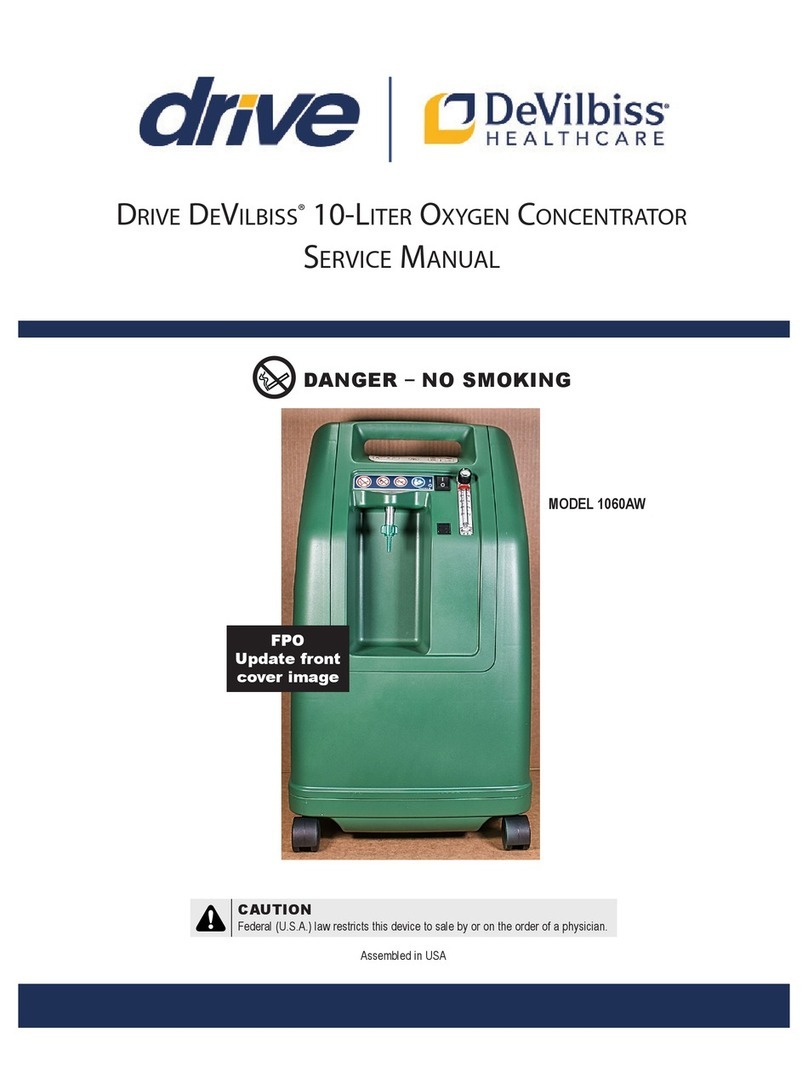
Drive DeVilbiss Healthcare
Drive DeVilbiss Healthcare 1060AW Service manual

Philips
Philips SimplyGo user manual
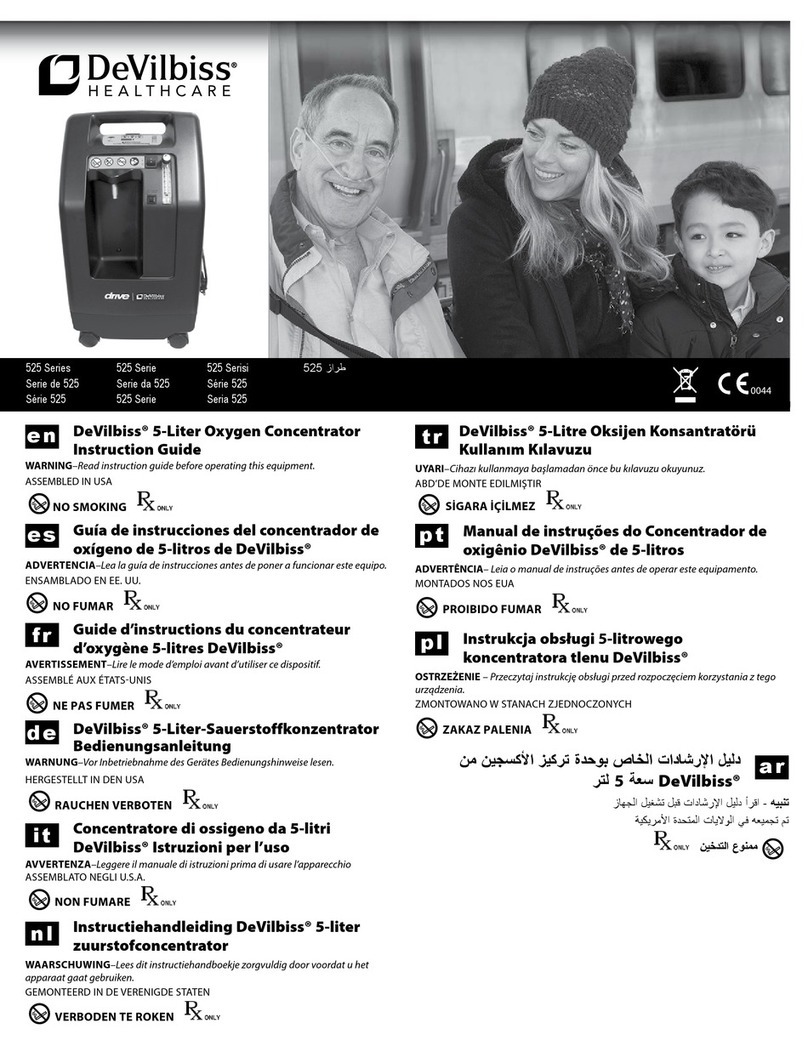
DeVilbiss
DeVilbiss 525 Series Instruction guide
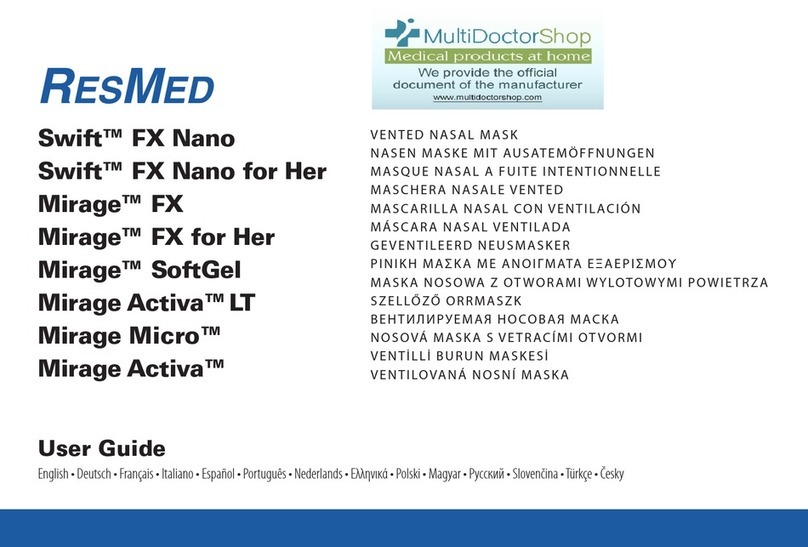
ResMed
ResMed Swift FX Nano user guide
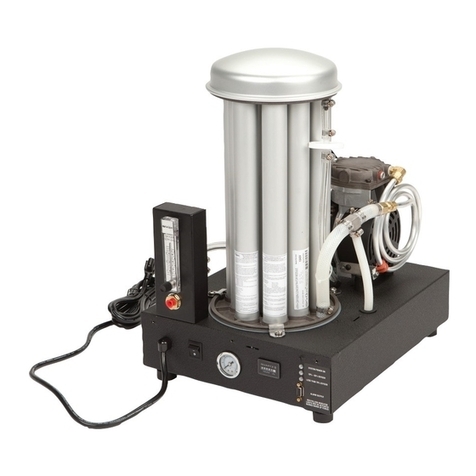
AirSep
AirSep SeQual Workhorse Series instruction manual
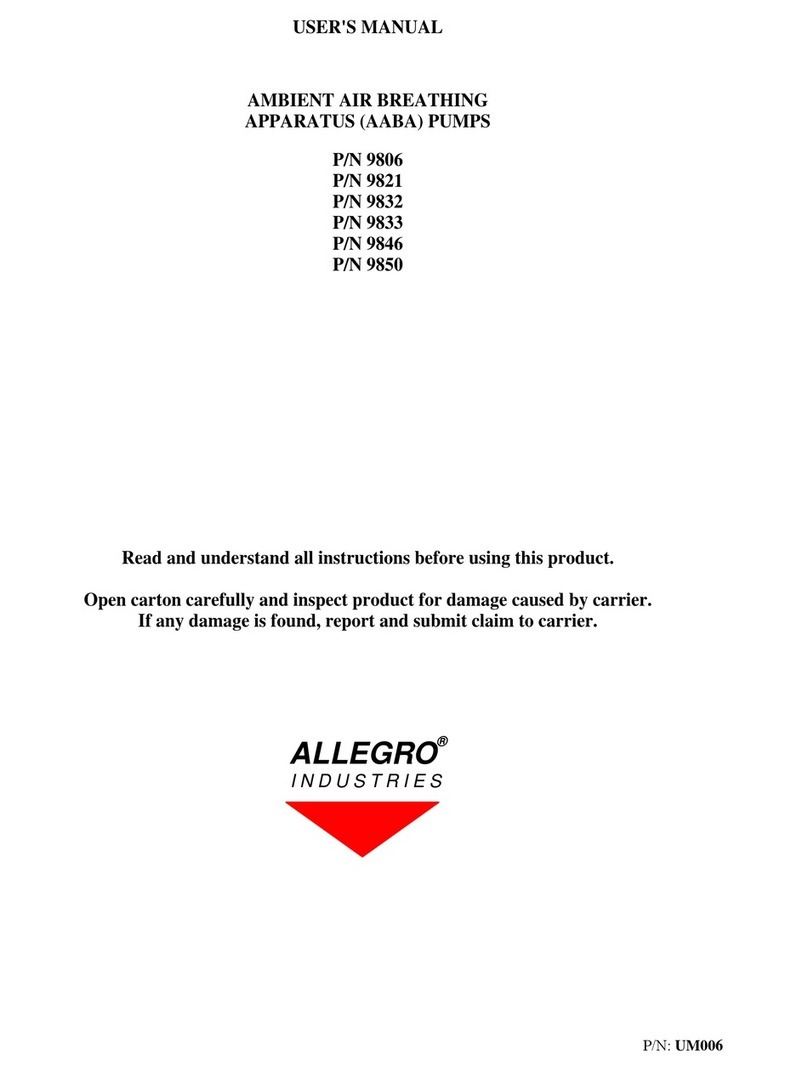
Allegro Industries
Allegro Industries 9806 user manual
